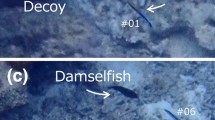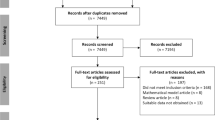Abstract
While the unique hunting behavior of archerfish has received considerable scientific attention, the specific social cues that govern behaviors like intraspecific kleptoparasitism in the species are less understood. This paper asks whether the use of a robotic facsimile representing an archerfish can elicit a social response if it approximates an archerfish’s appearance, along with key features of its hunting behavior. We found that the fish respond to the robot when it hunted, as indicated by decreasing distances between the robot and fish (and among the fish) during the robot’s hunting behavior sequence, as well as higher net transfer entropy when the robot was hunting. These effects were present even when the robot’s “hunt” was unproductive and did not result in food. The temporal pattern of fish approach to the robot and each other indicated that the segment of robot hunting behavior proximal to the robotic facsimile shot elicited fish behavior initially. However, earlier cues in the robot’s hunting sequence became important following more experience with a food contingency. This indicates that further studies could use a robotic facsimile to conduct a detailed stimulus analysis, changing aspects of the robot’s appearance and behavior to uncover the basic mechanisms of information transfer among individuals in a social hunting scenario.











Similar content being viewed by others
Notes
* indicates an F value for which Mauchly’s test indicated significant evidence of violation of sphericity and so Greenhouse–Geisser correction was applied.
References
Abaid N, Bartolini T, Macrì S, Porfiri M (2012) Zebrafish responds differentially to a robotic fish of varying aspect ratio, tail beat frequency, noise, and color. Behav Brain Res 233(2):545–553
Abaid N, Marras S, Fitzgibbons C, Porfiri M (2013) Modulation of risk-taking behaviour in golden shiners (Notemigonus crysoleucas) using robotic fish. Behav Process 100:9–12
Ben-Simon A, Ben-Shahar O, Vasserman G, Segev R (2012) Predictive saccade in the absence of smooth pursuit: interception of moving targets in the archer fish. J Exp Biol 215(24):4248–4254
Bierbach D, Lukas J, Bergmann A, Elsner K, Höhne L, Weber C, Weimar N, Arias-Rodriguez L, Mönck HJ, Nguyen H et al (2018) Insights into the social behavior of surface and cave-dwelling fish (Poecilia mexicana) in light and darkness through the use of a biomimetic robot. Front Robot AI 5:3
Butail S, Bartolini T, Porfiri M (2013) Collective response of zebrafish shoals to a free-swimming robotic fish. PLoS ONE 8(10):e76123
Butail S, Polverino G, Phamduy P, Del Sette F, Porfiri M (2014) Influence of robotic shoal size, configuration, and activity on zebrafish behavior in a free-swimming environment. Behav Brain Res 275:269–280
Cazenille L, Collignon B, Chemtob Y, Bonnet F, Gribovskiy A, Mondada F, Bredeche N, Halloy J (2018) How mimetic should a robotic fish be to socially integrate into zebrafish groups? Bioinspir Biomimetics 13(2):025001
Coulson R, Utter B, Brown M, Brown A (2018) Assessing the significance of tail actuation strategy in ethorobotic fish. In: 2018 IEEE international conference on systems, man, and cybernetics (SMC). IEEE, pp 351–356
De Lellis P, Cadolini E, Croce A, Yang Y, di Bernardo M, Porfiri M (2019) Model-based feedback control of live zebrafish behavior via interaction with a robotic replica. IEEE Trans Rob
Dill L, Davis BD (2012) Intraspecific kleptoparasitism and counter-tactics in the archerfish (Toxotes chatareus). Behaviour 149(13–14):1367–1394
Gautrais J, Jost C, Soria M, Campo A, Motsch S, Fournier R, Blanco S, Theraulaz G (2009) Analyzing fish movement as a persistent turning walker. J Math Biol 58(3):429–445
Goldstein SR, Hall D (1990) Variable ratio control of the spitting response in the archer fish (Toxotes jaculator). J Comp Psychol 104(4):373
Jones NA, Webster M, Templeton CN, Schuster S, Rendell L (2018) Presence of an audience and consistent interindividual differences affect archerfish shooting behaviour. Anim Behav 141:95–103
Kim C, Ruberto T, Phamduy P, Porfiri M (2018) Closed-loop control of zebrafish behaviour in three dimensions using a robotic stimulus. Sci Rep 8(1):657
Ladu F, Bartolini T, Panitz SG, Chiarotti F, Butail S, Macrì S, Porfiri M (2015) Live predators, robots, and computer-animated images elicit differential avoidance responses in zebrafish. Zebrafish 12(3):205–214
Landgraf T, Bierbach D, Nguyen H, Muggelberg N, Romanczuk P, Krause J (2016) Robofish: increased acceptance of interactive robotic fish with realistic eyes and natural motion patterns by live trinidadian guppies. Bioinspir Biomimetics 11(1):015001
Landgraf T, Nguyen H, Schröer J, Szengel A, Clément RJ, Bierbach D, Krause J (2014) Blending in with the shoal: robotic fish swarms for investigating strategies of group formation in guppies. In: Conference on biomimetic and biohybrid systems. Springer, pp 178–189
Marras S, Porfiri M (2012) Fish and robots swimming together: attraction towards the robot demands biomimetic locomotion. J R Soc Interface 9(73):1856–1868
Mwaffo V, Anderson RP, Butail S, Porfiri M (2015) A jump persistent turning walker to model zebrafish locomotion. J R Soc Interface 12(102):20140884
Newport C, Wallis G, Temple SE, Siebeck UE (2013) Complex, context-dependent decision strategies of archerfish, Toxotes chatareus. Anim Behav 86(6):1265–1274
Polverino G, Karakaya M, Spinello C, Soman VR, Porfiri M (2019) Behavioural and life-history responses of mosquitofish to biologically inspired and interactive robotic predators. J R Soc Interface 16(158):20190359
Porfiri M (2018) Inferring causal relationships in zebrafish–robot interactions through transfer entropy: a small lure to catch a big fish. Anim Behav Cogn 5(4):341–367
Reinel C, Schuster S (2016) Archerfish fast-start decisions can take an additional variable into account. J Exp Biol 219:2844–2855
Rischawy I, Blum M, Schuster S (2015) Competition drives sophisticated hunting skills of archerfish in the wild. Curr Biol 25(14):R595–R597
Rischawy I, Schuster S (2013) Visual search in hunting archerfish shares all hallmarks of human performance. J Exp Biol 216(16):3096–3103
Romano D, Donati E, Benelli G, Stefanini C (2019) A review on animal–robot interaction: from bio–hybrid organisms to mixed societies. Biol Cybern 113(3):201–225
Romano D, Benelli G, Kavallieratos NG, Athanassiou CG, Canale A, Stefanini C (2020a) Beetle–robot hybrid interaction: sex, lateralization and mating experience modulate behavioural responses to robotic cues in the larger grain borer Prostephanus truncatus (horn). Biol Cybern 114(4):473–483
Romano D, Benelli G, Stefanini C (2021) Opposite valence social information provided by bio-robotic demonstrators shapes selection processes in the green bottle fly. J R Soc Interface 18(176):20210056
Romano D, Elayan H, Benelli G, Stefanini C (2020b) Together we stand-analyzing schooling behavior in naive newborn guppies through biorobotic predators. J Bionic Eng 17(1):174–184
Romano D, Stefanini C (2021) Unveiling social distancing mechanisms via a fish–robot hybrid interaction. Biol Cybern 1–9
Schlegel T, Schmid CJ, Schuster S (2006) Archerfish shots are evolutionarily matched to prey adhesion. Curr Biol 16(19):R836–R837
Schlegel T, Schuster S (2008) Small circuits for large tasks: high-speed decision-making in archerfish. Science 319(5859):104–106
Schuster S, Rossel S, Schmidtmann A, Jager I, Poralla J (2004) Archer fish learn to compensate for complex optical distortions to determine the absolute size of their aerial prey. Curr Biol 14(17):1565–1568
Schuster S, Wöhl S, Griebsch M, Klostermeier I (2006) Animal cognition: how archer fish learn to down rapidly moving targets. Curr Biol 16(4):378–383
Steel EA, Guttorp P, Anderson JJ, Caccia DC (2001) Modeling juvenile salmon migration using a simple Markov chain. J Agric Biol Environ Statis 6(1):80
Swain DT, Couzin ID, Leonard NE (2011) Real-time feedback-controlled robotic fish for behavioral experiments with fish schools. Proc IEEE 100(1):150–163
Timmermans P, Souren P (2004) Prey catching in archer fish: the role of posture and morphology in aiming behavior. Physiol Behav 81(1):101–110
Utter B, Brown A (2020) Open-source five degree of freedom motion platform for investigating fish–robot interaction. HardwareX 7:e00107
van den Berg T, (2011) Calibrating the Ornstein–Uhlenbeck (Vasicek) model. http://www.sitmo.com/article/calibrating-the-ornstein-uhlenbeck-model/. View date October 24th
Wöhl S, Schuster S (2007) The predictive start of hunting archer fish: a flexible and precise motor pattern performed with the kinematics of an escape c-start. J Exp Biol 210(2):311–324
Acknowledgements
The authors thank members of the Villanova University Comparative Cognition Laboratory—Sara Glass, Christina Folan, Heather Hall, William McCarthy, Isabella McIlvanine, Ryan Pluck, Griffin Richards, and Nicole Xiong—for their assistance coding video data.
Author information
Authors and Affiliations
Contributions
A.B., M.B., and B.U. conceived the study. B.U. developed the lure morphology and robot shooting behavior. M.B., B.U., and A.B conducted the experiments. A.B. and S.F. developed the robotic control system. M.B., B.U., and A.B. analyzed the data. All authors contributed to the interpretation of results and the preparation of the manuscript.
Corresponding author
Ethics declarations
Conflict of interest
The authors disclose no conflicts of interest
Additional information
Communicated by Donato Romano.
Publisher's Note
Springer Nature remains neutral with regard to jurisdictional claims in published maps and institutional affiliations.
This article is published as part of the Special Issue on Animal–Robot Interaction and Biohybrid Organisms.
Supplementary Information
Below is the link to the electronic supplementary material.
Rights and permissions
About this article
Cite this article
Brown, A.A., Brown, M.F., Folk, S.R. et al. Archerfish respond to a hunting robotic conspecific. Biol Cybern 115, 585–598 (2021). https://doi.org/10.1007/s00422-021-00885-7
Received:
Accepted:
Published:
Issue Date:
DOI: https://doi.org/10.1007/s00422-021-00885-7




